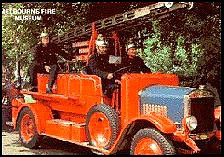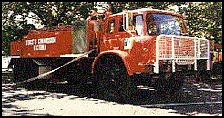Vintage Appliance Timeline
|
39 Gisborne Street, East Melbourne, 3002, Australia
(Cnr. Gisborne Street and Victoria Parade), East Melbourne
|
| 1926 Dennis Pumper Reg. No. 1690
Dennis Brothers introduced a 30 cwt (1.5 Tonne) truck chassis in 1925. These were very popular as delivery vans, and included many novel features for their time. This led to their adoption in a wide variety of other roles. In 1926 a lengthened version of the 30 cwt chassis was offered as a light Fire Appliance. These relatively inexpensive machines proved extremely popular, especially as the looming depression caused local authorities to begin severely restricting their budgets.
Novel features included four wheel brakes, and pneumatic tyres (both fitted at a time when official regulations still prevented their general use in England, and in part were instrumental in changing perceptions on the efficiency of these items), one piece cast cylinder blocks cast all in one piece with the crankcase, and a clutch housing and gearbox all bolted together in a single unit, and the mounting of all these items direct onto the chassis, instead of separate sub - frames.
With the basic 36 B.h.p. motors a variety of different size pumps could be fitted to meet the customer's
requirements. Large numbers of these vehicles were exported to the "Dominions".
The main body style followed the traditional "Braidwood" layout. Although some examples came as specialised appliances e.g. Salvage, or Emergency Tenders. As often happens with Fire Appliances, the chassis is superseded for a variety of reasons, but the pumps are still sound, and are remounted onto the replacement vehicle. It was probably for this reason that this vehicle is no longer fitted with a pump, although the mounting points show definite signs of having a pump fitting in place at some time.

This Appliance is originally from New South Wales, and H.F.E.A.A. published records indicate that it may have been from a large group (28 vehicles in all) titled "DENNIS 250 sv." and fitted with a 250 G.P.M. pumps. These vehicles were progressively commissioned between 1927 and 1930. It is believed to have served at Thyrrell.
A number of similar vehicles, from batches imported from England, also operated in Melbourne, and Country Victoria.
For the technically, or statistically minded, the following details are on the builders plate, still mounted on the front fire wall:
Chassis No: 7596
Engine: 410170.24
Gearbox: 12837
Back axle: 23124
Weight: 3 T 13 Cwt
(3.8 Tne.)
|
 Back to Timeline Back to Timeline
|
Vintage Appliance Timeline

|
39 Gisborne Street, East Melbourne, 3002, Australia
(Cnr. Gisborne Street and Victoria Parade), East Melbourne

|
 1975 "M" Series Bedford Fire Tanker 1975 "M" Series Bedford Fire Tanker Forests Commission of Victoria Forests Commission of Victoria
(Department of Conservation and Environment)
Original Reg. No: MZF 347
Chassis No: CJ465323
Engine No: F6293025
This vehicle was commissioned into service with the Forests Commission of Victoria (now the Department of Conservation and Natural Resources) on the 2nd of October, 1975. It is still a fully commissioned "reserve"
tanker with the Fire Management Branch of the Department (although it wears the "old" Forests Commission logos), but has been housed in the Museum since December 1994.
 The original purchase price of the vehicle was $8884.00, and was built up at the Forests Commission Fire Protection Workshops, Kyle Road, North Altona, workshops, it was issued to the Kallista depot on the 10th of October, 1975. The original purchase price of the vehicle was $8884.00, and was built up at the Forests Commission Fire Protection Workshops, Kyle Road, North Altona, workshops, it was issued to the Kallista depot on the 10th of October, 1975.
All of its working life, except when on task forces attending major fires, was in the Kallista - Gembrook areas of the Dandenong Ranges.
As originally fitted out (direct quote from workshops log sheet) it was:
Fitted with 16 H.P. "Briggs & Stratton No. 8" pump, (Honda Pump of equivalent capacity now installed) fitted with control linkages, hand primed pump, and "super trap" muffler. 5 synthetic hoses with quick release couplings (Nos.: 118 - 122). Driver side front tray made removable. "Stortz" couplings fitted to suction line, blank caps fitted, 2 x 15 Ft. (4 M.) suction hoses supplied with "Stortz" couplings. Battery charger re - coupled behind driver side seat. Mudguard front of rear wheels removed & replaced with mud flaps. Tie rod guard fitted to front axle. Voltmeter fitted to dash. Quick release couplings fitted to delivery sides of front tray. Quick release couplings fitted to 2 directors.
The workshop records for the ensuing years show various repairs, modifications, and updates of equipment. Much of the wear and tear occasioned by working "Off Road" in four wheel drive on forest tracks shows up on these sheets. When not attending fires, large and small, the vehicle participated in "fuel reduction burns", and water cartage for construction works (walking paths, picnic areas etc.) by forest staff.
|
| Back to Timeline
|
|
